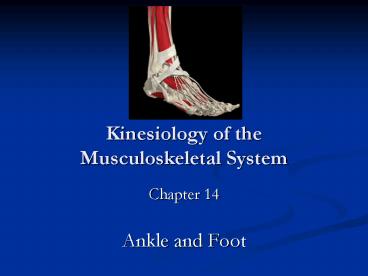Kinesiology of the Musculoskeletal System PowerPoint PPT Presentation
1 / 30
Title: Kinesiology of the Musculoskeletal System
1
Kinesiology of the Musculoskeletal System
- Chapter 14
- Ankle and Foot
2
Ankle and Foot Overview
- Primary function is to provide shock absorption
and to impart thrust to the body during walking
or ambulation - Pliability to absorb force of body weight
- Rigidity to provide propulsive thrust
- Functions through an interaction of interrelated
joints, connective tissues and muscles
3
Osteology
- Ankle refers primarily to the talocrural joint,
but includes proximal and distal tibiofibular
joints - Foot refers to all structures distal to the
tibial and fibula - Talus bone is included in the definition of both
the ankle and foot
4
Foot Anatomical Regions
- Rearfoot talus, calcaneus and subtalar joint
- Midfoot remaining tarsal bones, transverse
tarsal joint and distal intertarsal joints - Forefoot
- metatarsals
- and phalanges,
- tarsometatarsal
- joints
5
Bones of the Lower Leg
- Fibula
- Transfers minority of weight bearing load
through the leg - Distal end is the lateral malleolus of the ankle
-
Tibia - Distal end is the medial malleolus of the ankle
- Transfers majority of weight bearing load through
the leg - Torsion Angle of tibia is approximately 20-30
degrees of intra-tibial external rotation
6
Talocrural Joint
7
Tarsal Bones
- Talus
- Articulates with the tibia and fibula at the
talocrual joint, and with the navicular bone at
the talonavicular joint - Important kinesiological role in the foot/ankle
and in the entire lower extremity - Superior aspect covered with articular cartilage
8
Tarsal Bones (cont.)
- Calcaneus
- Articulates with the talus superiorly at the
subtalar joint and with the cuboid at the
calcaneocuboid joint - Largest tarsal bone built to absorb shock of
heel strike - Muscular attachments for achilles tendon,
intrinsic foot musculature and plantar fascia - Navicular
- Articulates with the talus at the talonavicular
joint and with cuneiform bones - Site of attachment for Tibialis Posterior
9
(No Transcript)
10
(No Transcript)
11
Tarsal Bones (cont.)
- Cuneiforms
- Contribute to the transverse arch
- Articulations with cuboid, navicular and MTs
- Cuboid
- Articulates with calcaneus, lateral cuneiform,
navicular and MTs - Site of attachment of Peroneus Longus
12
Metatarsals and Phalanges
- 5 MTs, 14 Phalanges
- Condylar joints
- Plantar surface of MTs are slightly concave
longitudinally - 1st MT is the shortest and thickest
- 2nd MT is the longest transfer of load travels
through 1st and 2nd during gait
13
Arthrology
- Major joints of the ankle and foot are the
talocrural, subtalar, and transverse tarsal
joints - Talus mechanically involved in all 3 joints and
is covered 70 by articular cartilage
14
Motions at the Ankle Foot
- Motions about the foot and ankle are considered
- tri-planar but move through an oblique axis
- Pronation eversion/abduction/dorsiflexion
- Supination inversion/adduction/plantar flexion
15
Tibiofibular Joints
- Proximal TFJ synovial joint with a joint
capsule allows stresses put onto tibia to be
transferred to the fibula - Distal TFJ synarthrosis with very little motion
- Interosseous ligament
- Anterior Tibiofibular Ligament
- Posterior Tibiofibular Ligament
16
Ankle Ligaments
17
Ankle Ligaments
18
High Ankle Sprain
19
Talocrural Joint
- Aka Mortise Joint joint between tibia,
fibular and talus - Reinforced by medial and lateral collateral
ligaments - Primary motion at TC joint is dorsiflexion and
plantarflexion - ATFL Anterior Talofibular Ligament one
component of the lateral collateral ligament
most often injured in inversion sprain
20
(No Transcript)
21
Subtalar Joint
- Tri-planar pronation/supination
- Pronation mostly eversion/abduction
- Supination mostly inversion/adduction
- During weight bearing activity, most of SJ motion
occurs as the talus rotates and swan dives over
a fixed calcaneus - Ligaments of the STJ prevent extreme inversion
and eversion - Full supination increases rigidity of the midfoot
and is the closed pack position - Full pronation increases overall flexibility of
the midfoot
22
Subtalar Joint (cont.)
23
Transverse Tarsal Joint
- Along with subtalar joint, TTJ controls most of
pronation/supination - Allows foot to accommodate different surfaces
24
Joints of the Foot
25
Medial Longitudinal Arch of the Foot
- Primary load bearing
- and shock-absorbing
- structure of the foot
- Height of arch is
- maintained by plantar
- fascia, intrinsic foot
- muscles, spring
- ligament and stability
- of midfoot joints
26
Medial Longitudinal Arch (cont.)
- Pes Planus dropped MLA
- Flexible Pes Planus
- Rigid Pes Planus
- Pes Cavus raised MLA
- Less common than pes planus
- Poor shock absorption
- Possible association with stress fractures
27
Clinical Considerations
- Patient/athlete with Pes Planus or Pronated
feet often fitted with an orthotic and prescribed
strengthening exercises to control pronation - Strengthen tibialis posterior, intrinsic foot
muscles, hip external rotators and abductors
stretch hip adductors, TFL, hip flexors consider
motion control athletic shoes - Patient/athlete with Pes Cavus or Supinated
feet often prescribed cushioning orthotics and/or
athletic shoes
28
Windlass Effect
- Mechanism through which intrinsic and extrinsic
plantarflexors place tension on the medial
longitudinal arch creating a rigid/stable mid
and forefoot enabling the foot to accept the
biomechanical stresses of push off during gait
29
Windlass effect (cont.)
30
References
- Neumann, D. Kinesiology of the Musculoskeletal
System. 2002. Human Kinetics.

